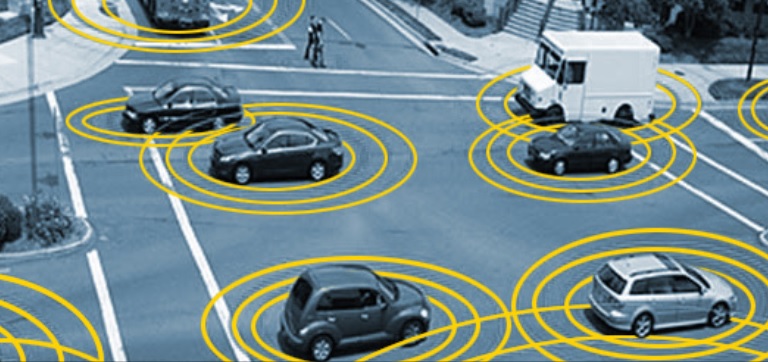HNTB
As an influx of connected and autonomous vehicles reaches American roads over the next decade, many sweeping changes to our transportation network are expected. Increased lane capacity, more efficient movement of freight and improved safety are all commonly cited, and expected, benefits.

Connected vehicles electronically "talk" to each other and infrastructure to communicate safety and other messages, and autonomous vehicles take the technology a step further by partially or completely eliminating the need for a driver. As these technologies develop and gradually reframe our transportation networks, they will have a profound effect on our cities and communities. Connected and autonomous vehicles have the potential to significantly impact urban design and real-estate developments, and spark change in land-use in cities across the nation. In the distant future, they even may completely re-frame the way cities are designed.
It's well established that investments in transportation deliver returns that are impactful both from a personal and financial point of view. Studies suggest that highways provided a 32 percent rate of return on investment from 1950 to 1990. The rating agency Moody's has estimated a $1.44 increase in gross domestic product for every additional dollar invested in infrastructure.
When these technologies become the norm, where will these changes begin?
Decreased need for parking
To start, connected and autonomous vehicles will significantly affect parking needs in some cities. Currently, large amounts of land in urban areas are used for parking garages, lots and on-street facilities. In the future, autonomous and connected vehicles may be operated by fleet management companies that require vehicles to be in constant operation to move people and freight — drastically reducing the need for parking facilities.
Parking lots could be converted into ride-hailing hubs for connected and autonomous vehicles
With these spaces freed, cities would have an opportunity to reframe much of their infrastructure to install facilities that complement these new transportation technologies. For instance:
■ Parking lots could be converted into ride-hailing hubs for connected and autonomous vehicles, complete with vehicle staging, queuing and charging capabilities.
■ On-street parking could be converted into pedestrian or green space, creating more livable, walkable cities.
■ Parking garages could be converted into offices or residences, providing job opportunities and space for population growth.
With this in mind, parking garages built today should be designed for later conversion into functional buildings, and include level floors, exterior ramps, higher ceilings, greater support structures, ducts and shafts for future utilities, and other elements.
Autonomous Shuttles
These changes to parking amenities help us understand some of the opportunities that are coming. Already, there is one technology that is having a profound impact on transportation, educational, medical and other spaces: autonomous shuttles.
These shuttles can be used as people-movers at airports, college or medical campuses, business parks, cities and communities, environmentally sensitive areas like resorts and parks, and more. They could even complement existing transit systems by offering first- and last-mile services between passenger rail and transit stations and other facilities.
Widespread adoption of autonomous vehicles is expected to take at least a decade, so autonomous shuttles present a solution that could be implemented much sooner on a broad scale. These shuttles have already been implemented or tested in certain locations around the world, including the US.
Shuttles are giving us a first look at the benefits and impacts of connected and autonomous vehicles
Autonomous shuttles not only support transportation, commercial and residential developments, they also can provide mobility to those who don't readily have access to transportation options, including disabled, aged or young people. They can even support transit oriented development or be designed into new communities.
These shuttles are giving us a first look at the benefits and impacts of connected and autonomous vehicles, and are paving the way to understanding their long-term impacts on our cities and transportation networks.
Nomadization
While autonomous vehicles may soon change the parking landscape in cities and autonomous shuttles already are improving mobility in certain places, the long-term effects of connected and autonomous vehicles may one day include drastic urban redesign.
People may be able to work, eat and sleep while occupying their vehicles
Although this may seem farfetched now, if autonomous vehicles eventually become one of the primary modes of transport, people may be able to work, eat and sleep while occupying their vehicles. This could afford people a choice to live further from work, thus creating much more pronounced urban sprawl.
While this may be positive for some land developers, it could have a negative effect on city life. Resources would be strained in remote communities, and infrastructure across entire metro areas would be difficult to maintain, potentially leading to neglect.
If this trend were to go even further, consider the impact it could have on urban design and residential life. People might one day choose to live on the road as futuristic nomads, creating a "nomadization" concept in transportation and housing. With this new trend, houses may be substituted for autonomous modules on wheels, turning upside down our concept of normal residential life in cities nationwide.
Of course, these are simply concepts that may never come to fruition. But it's important to begin considering various possibilities these technologies may bring.
As the US auto industry and technology suppliers move closer to increasing numbers of autonomous vehicles on our roads, and engineers and planners help develop the needed transportation infrastructure, dramatic paradigm shifts in land-use are expected. The look and feel of our roadways and cities may change, and our concept of mobility could completely transform.
Cities and transportation agencies should begin thoughtful discussions now to consider how to plan, pay for and prepare their infrastructure to ensure they are ready for this exciting new era.




